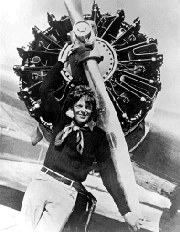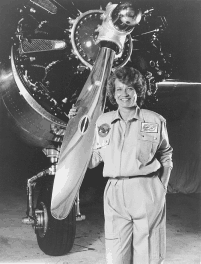An American Heroine

 Amelia Earhart and her Lockheed Electra |
Over sixty years after Amelia Earhart vanished mysteriously in the Pacific during her attempt to become the first person to circumnavigate the world along the equator, Linda Finch, a San Antonio businesswoman, accomplished pilot, and aviation historian, recreated and completed her idol's last flight as a tribute to the aviation pioneer's spirit and vision.
On March 17, 1997, Ms. Finch and a navigator took off from Oakland International Airport, California, in a restored Lockheed Electra 10E, the same make and model aircraft that Earhart used on her last journey. The mission to fulfill Amelia Earhart's dream was called “World Flight 1997.” Although Ms. Finch was not the first to attempt Earhart's around-the-world journey, she was the first to do it in a historic airplane. Linda Finch closely followed the same route that Earhart flew, stopping in 18 countries before finishing the trip two and a half months later when she landed back at the Oakland Airport on May 28.
Over a million school children and others were able to follow the flight daily through an interactive web site part of a free multimedia educational program called “You Can Soar,” provided by the project's sponsor.
 Linda Finch, pilot of World Flight 1997 |
Linda Finch acquired a vintage Lockheed Electra in 1994 for this adventure. Using original drawings and photographs, the 1935 aircraft was meticulously and accurately restored, right down to its rivets. The classic plane is one of only two in existence capable of flight. The only exception to the original is that Finch's Electra was equipped with modern navigation and communication equipment whereas Earhart had rudimentary radio communications by today's standards.
World Flight, Inc., is a non-profit organization founded by Linda Finch. “World Flight 1997” was sponsored by Pratt & Whitney, a unit of United Technologies Corporation. Pratt & Whitney created the original Wasp engines used to power Amelia Earhart's Lockheed Electra.
Amelia Earhart is the most celebrated aviatrix in history and was one of the most famous women of her time. As America's charismatic “Lady of the Air,” she set many aviation records, including becoming the first woman to fly across the Atlantic in 1928 as a passenger, the first woman (and second person after Lindbergh) to fly solo across the Atlantic in 1932, and the first person to fly alone across the Pacific, from Honolulu, Hawaii, to Oakland, California, in 1935. In an era when men dominated aviation, she was truly a pioneer.
Amelia Mary Earhart was born on July 24, 1897 in Atchison, Kansas. During her early years, she was constantly hampered by lack of funds and worked at a variety of jobs to fulfill her desire to fly. She held positions as a teacher, nursing assistant, photographer, secretary, and social worker. Earhart even bought a truck and hauled gravel to earn money to buy a plane.
AE, as she was called by her friends, was a modern woman. She was courageous, independent, and had a strong social conscience. She fought for international peace, equality for women, the advancement of women in aviation, and the viability of commercial aviation. During her lifetime, she was a role model to millions of people whom she motivated and encouraged through her actions.
In 1937, Earhart attempted to become the first person ever to fly around the world at its longest point—the equator—a challenging trip of 29,000 mi. She intended this feat to be the last record-setting flight of her legendary career. It was to be her swan song. Amelia was accompanied on the trip by a highly experienced navigator, Frederick J. Noonan.
On July 2, 1937, after successfully completing 22,000 mi of the journey in her silver twin-engine Electra, she took off from Lae, New Guinea, on the longest and most dangerous leg of her flight, some 18 hours and 2,556 mi across the vast ocean to Howland Island where the U.S. government had constructed an airfield and stored fuel supplies for her use.
Howland Island is uninhabited, a tiny island in the North Pacific about one and a half mis long and a half mile wide. The United States Coast Guard had stationed the cutter, Itasca, off Howland to maintain radio communications with the Electra and assist Earhart in locating the minuscule atoll.
When the plane was due to reach its destination, Earhart reported to the Itasca that she thought that she was flying over Howland, but couldn't see it below. Evidently lost and confused, with her plane running low on fuel, she asked for help in “homing in” by radio to the tiny island. Her last words were, “We are running north and south,” presumably flying in a search pattern in hope of seeing the island. She lost critical radio communications with the Itasca and the cutter's radio operators could not get a bearing on her position. Repeated efforts by the Itasca to contact the fliers were unsuccessful and they were presumed out of fuel and lost at sea. An extensive land, air, and sea search lasting over two weeks failed to find them and no trace of the world's most famous female pilot, her navigator, or their plane has ever been found.—OTJ







